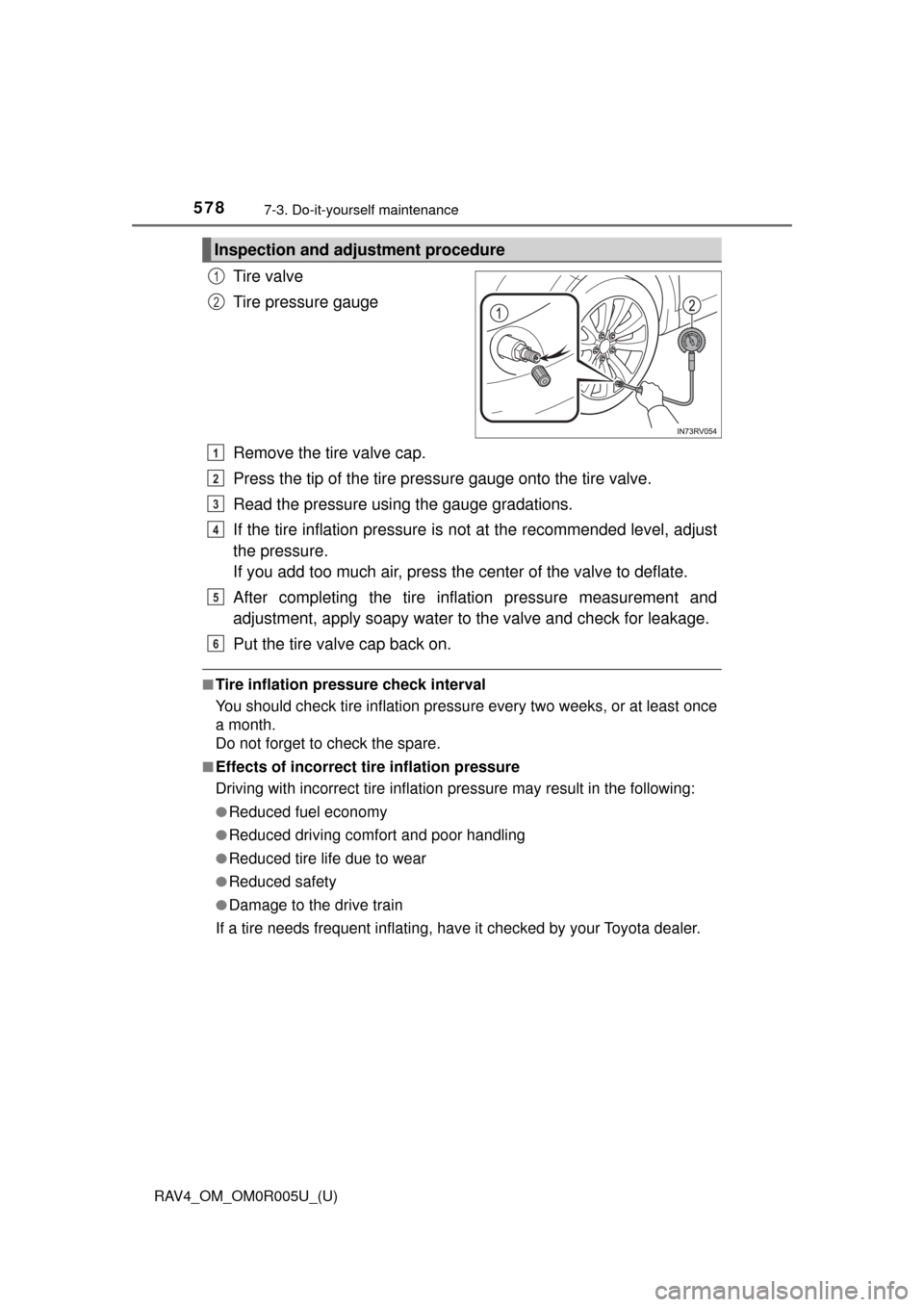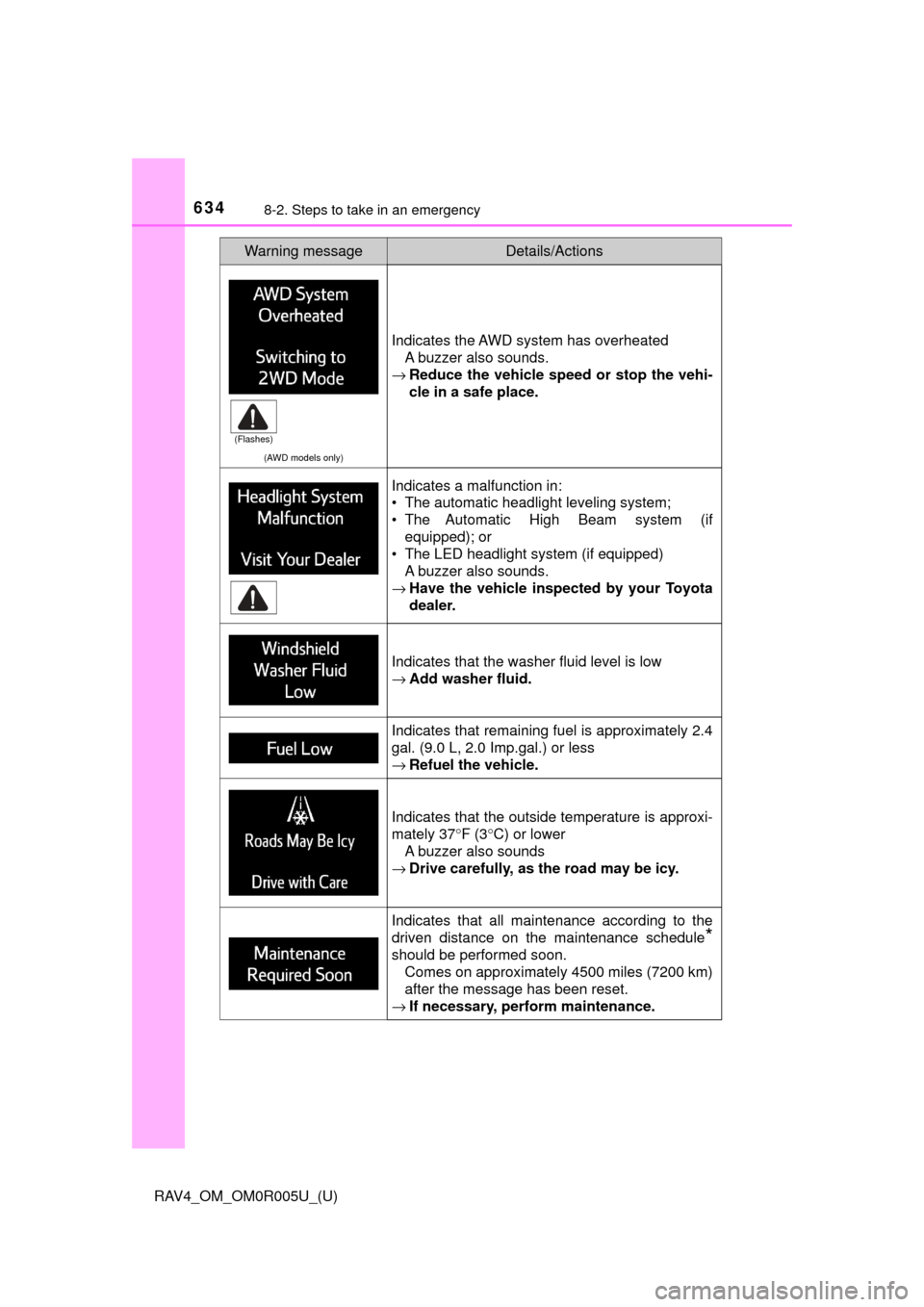Page 579 of 741

578
RAV4_OM_OM0R005U_(U)
7-3. Do-it-yourself maintenance
Tire valve
Tire pressure gauge
Remove the tire valve cap.
Press the tip of the tire pressure gauge onto the tire valve.
Read the pressure usi ng the gauge gradations.
If the tire inflation pressure is not at the recommended level, adjust
the pressure.
If you add too much air, press the center of the valve to deflate.
After completing the tire inflation pressure measurement and
adjustment, apply soapy water to the valve and check for leakage.
Put the tire valve cap back on.
■Tire inflation pressure check interval
You should check tire inflation pressure every two weeks, or at least once
a month.
Do not forget to check the spare.
■Effects of incorrect tire inflation pressure
Driving with incorrect tire inflation pressure may result in the following:
●Reduced fuel economy
●Reduced driving comfort and poor handling
●Reduced tire life due to wear
●Reduced safety
●Damage to the drive train
If a tire needs frequent inflating, have it checked by your Toyota dealer.
Inspection and adjustment procedure
1
2
1
2
3
4
5
6
Page 604 of 741
603
RAV4_OM_OM0R005U_(U)
8When trouble arises
8-1. Essential informationEmergency flashers .......... 604
If your vehicle has to be stopped in an
emergency ...................... 605
8-2. Steps to take in an emergency
If your vehicle needs to be towed ..................... 607
If you think something is wrong ......... 613
Fuel pump shut off system ............................ 614
If a warning light turns on or a warning buzzer
sounds ............................ 615
If a warning message is displayed......................... 625
If you have a flat tire.......... 641
If the engine will not start ..................... 654
If the electronic key does not operate properly
(vehicles with
smart key system) ........... 656
If the vehicle battery is discharged ................... 658
If your vehicle overheats ... 662
If the vehicle becomes stuck ............................... 665
Page 615 of 741
614
RAV4_OM_OM0R005U_(U)
8-2. Steps to take in an emergency
Fuel pump shut off system
Follow the procedure below to restart the engine after the system is
activated.
Vehicles without smart key system
Turn the engine switch to the “ACC” or “LOCK” position.
Restart the engine.
Vehicles with smart key system
Turn the engine switch to ACCESSORY mode or off.
Restart the engine.
To minimize the risk of fuel leakage when the engine stalls or
when an airbag inflates upon collision, the fuel pump shut off
system stops the supply of fuel to the engine.
NOTICE
■Before starting the engine
Inspect the ground under the vehicle.
If you find that fuel has leaked onto the ground, the fuel system has been
damaged and is in need of repair. Do not restart the engine.
1
2
1
2
Page 617 of 741

6168-2. Steps to take in an emergency
RAV4_OM_OM0R005U_(U)
Electric power steering system warning light (warning
buzzer)Indicates a malfunction in the EPS (Electric Power Steer-
ing) system
→ Have the vehicle inspected by your Toyota dealer
immediately.
Slip indicator
Indicates a malfunction in:
• The VSC/Trailer Sway Control system;
• The TRAC system;
• The AUTO LSD function; or
• The hill-start assist control system
The light will flash when the VSC/Trailer Sway Control or
the TRAC system is operating.
→ Have the vehicle inspected by your Toyota dealer
immediately.
Seat belt reminder light (warning buzzer)*2
Warns the driver and/or front passenger to fasten their
seat belts
→ Fasten the seat belt.
If the front passenger’s seat is occupied, the front
passenger’s seat belt also needs to be fastened to
make the warning light (warning buzzer) turn off.
Low fuel level warning light Indicates that remaining fuel is approximately 2.4 gal.
(9.0 L, 2.0 Imp. gal.) or less
→ Refuel the vehicle.
(Flashes)
(On the center panel)
Intuitive parking assist indicator (warning buzzer)*3 (if
equipped) Indicates a malfunction in the intuitive parking assist
→ Have the vehicle inspected by your Toyota dealer
immediately.
(On the center panel)
Intuitive parking assist indicator (warning buzzer)*4 (if
equipped) Indicates that the intuitive parking assist sensor is dirty or
covered with ice.
→ Clean the sensors.
(On the center panel)
Rear passengers’ seat belt reminder lights (warning
buzzer)
*2
Warn the rear passengers to fasten their seat belts
→ Fasten the seat belt.
Warning lightWarning light/Details/Actions
Page 620 of 741

6198-2. Steps to take in an emergency
RAV4_OM_OM0R005U_(U)
8
When trouble arises
*4: The corner and center indicators turn on and remain on after the indicatorfor the malfunctioning sensor turns on, and the vehicle indicator turns off
while the buzzer sounds for approximately 7 seconds.
■ SRS warning light
This warning light system monitors the airbag sensor assembly, front impact
sensors, side impact sensors (front door), side impact sensors (rear), driver’s
seat position sensor, driver’s seat belt buckle switch, front passenger occu-
pant classification system, “AIR BAG ON” indicator light, “AIR BAG OFF” indi-
cator light, front passenger’s seat belt buckle switch, driver’s seat belt
pretensioner, front passenger’s seat belt pretensioner and force limiter, air-
bags, interconnecting wiring and power sources. ( →P. 38)
■ Front passenger detection sensor, seat belt reminder and warning
buzzer
● If luggage is placed on the front passenger seat, the front passenger de\
tec-
tion sensor may cause the warning light to flash and the warning buzzer to
sound even if a passenger is not sitting in the seat.
● If a cushion is placed on the seat, the sensor may not detect a passenger,
and the warning light may not operate properly.
■ If the malfunction indicator la mp comes on while driving
First check the following:
● Is the fuel tank empty?
If it is, fill the fuel tank immediately.
● Is the fuel tank cap loose?
If it is, tighten it securely.
The light will go off after several driving trips.
If the light does not go off even after several trips, contact your Toyota dealer
as soon as possible.
Page 624 of 741

6238-2. Steps to take in an emergency
RAV4_OM_OM0R005U_(U)
8
When trouble arises
WARNING
■Maintenance of the tires (vehicles with the tire pressure warning
system)
Each tire, including the spare (if provided), should be checked monthly
when cold and inflated to the inflation pressure recommended by the
vehicle manufacturer on the vehicle placard or tire inflation pressure
label (tire and load information label). (If your vehicle has tires of a dif-
ferent size than the size indicated on the vehicle placard or tire inflation
pressure label [tire and load information label], you should determine
the proper tire inflation pressure for those tires.)
As an added safety feature, your vehicle has been equipped with a tire
pressure monitoring system (TPMS-ti re pressure warning system) that
illuminates a low tire pre ssure telltale (tire pressure warning light) when
one or more of your tires is significantly under-inflated. Accordingly,
when the low tire pressure telltale (tire pressure warning light) illumi-
nates, you should stop and check your tires as soon as possible, and
inflate them to the proper pressure. Driving on a significantly under-
inflated tire causes the tire to overheat and can lead to tire failure.
Under-inflation also reduces fuel effi ciency and tire tread life, and may
affect the vehicle’s handling and stopping ability.
Please note that the TPMS (tire pressure warning system) is not a sub-
stitute for proper ti re maintenance, and it is the driver’s responsibility to
maintain correct tire pressure, even if under-inflation has not reached
the level to trigger illumination of the TPMS low tire pressure telltale (tire
pressure warning light).
Your vehicle has also been equipped with a TPMS (tire pressure warn-
ing system) malfunction indicator to indicate when the system is not
operating properly. The TPMS (tire pressure warning system) malfunc-
tion indicator is combined with the lo w tire pressure telltale (tire pressure
warning light). When the system detects a malfunction, the telltale will
flash for approximately one minute and then remain continuously illumi-
nated. This sequence will continue upon subsequent vehicle start-ups as long as the malfunction exists. When the malfunction indicator is illu-
minated, the system may not be able to detect or signal low tire pres-
sure as intended.
TPMS (tire pressure warning system) malfunctions may occur for a vari-
ety of reasons, including the installation of replacement or alternate tires
or wheels on the vehicle that prevent the TPMS (tire pressure warning
system) from functioning properly. Always check the TPMS (tire pres-
sure warning system) malfunction te lltale after replacing one or more
tires or wheels on your vehicle to ensure that the replacement or alter-
nate tires and wheels allow the TPMS (tire pressure warning system) to
continue to function properly.
Page 635 of 741

6348-2. Steps to take in an emergency
RAV4_OM_OM0R005U_(U)
(AWD models only)
Indicates the AWD system has overheatedA buzzer also sounds.
→ Reduce the vehicle speed or stop the vehi-
cle in a safe place.
Indicates a malfunction in:
• The automatic headlight leveling system;
• The Automatic High Beam system (if
equipped); or
• The LED headlight system (if equipped)
A buzzer also sounds.
→ Have the vehicle inspect ed by your Toyota
dealer.
Indicates that the washer fluid level is low
→ Add washer fluid.
Indicates that remaining fuel is approximately 2.4
gal. (9.0 L, 2.0 Imp.gal.) or less
→Refuel the vehicle.
Indicates that the outside temperature is approxi-
mately 37 °F (3 °C) or lower
A buzzer also sounds
→ Drive carefully, as the road may be icy.
Indicates that all maintenance according to the
driven distance on the maintenance schedule
*
should be performed soon.
Comes on approximately 4500 miles (7200 km)
after the message has been reset.
→ If necessary, perform maintenance.
Warning messageDetails/Actions
(Flashes)
Page 655 of 741

654
RAV4_OM_OM0R005U_(U)
8-2. Steps to take in an emergency
If the engine will not start
One of the following may be the cause of the problem:
●There may not be sufficient fuel in the vehicle’s tank.
Refuel the vehicle.
● The engine may be flooded.
Try to restart the engine again following correct starting procedures.
(→ P. 196, 198)
● There may be a malfunction in the engine immobilizer system.
(→ P. 73)
One of the following may be the cause of the problem:
● The battery may be discharged. ( →P. 658)
● The battery terminal connections may be loose or corroded.
The engine starting system may be malfunctioning due to an electrical
problem such as an open circuit or a blown fuse. However, an interim
measure is available to start the engine. ( →P. 655)
If the engine will not start eve n though correct starting proce-
dures are being followed ( →P. 196, 198), consider each of the fol-
lowing points:
The engine will not start even though the starter motor operates
normally.
The starter motor turns over slowly, the interior lights and head-
lights are dim, or the horn does not sound or sounds at a low
volume.
The starter motor does not turn over (vehicles with smart key
system).